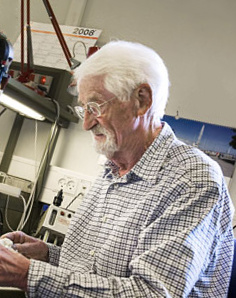Jens Christian Skou facts for kids
Quick facts for kids
Jens Christian Skou
|
|
|---|---|

Skou in 2008
|
|
| Born | 8 October 1918 Lemvig, Denmark
|
| Died | 28 May 2018 (aged 99) Risskov, Aarhus, Denmark
|
| Nationality | Danish |
| Alma mater | University of Copenhagen |
| Known for | Na+,K+-ATPase |
| Awards | Nobel Prize in Chemistry (1997) Fernström Prize (1985) |
| Scientific career | |
| Fields | Physiology, Biophysics, Biochemistry |
| Institutions | Aarhus University |
Jens Christian Skou (born October 8, 1918 – died May 28, 2018) was a Danish scientist. He was a biochemist, which means he studied the chemistry of living things. He won a Nobel Prize for his important discoveries.
Contents
Early Life and Education
Jens Christian Skou was born in Lemvig, Denmark. His family was well-off. His father sold wood and coal. After his father passed away, his mother took over the family business.
When he was 15, Skou went to a special boarding school. He later studied medicine at the University of Copenhagen. He finished his medical degree in 1944. In 1954, he earned his doctorate degree.
He started working at Aarhus University in 1947. He became a professor of biophysics in 1977. Biophysics is a field that uses physics to study living things. He retired in 1988 but kept working in his office.
Discovering the Sodium-Potassium Pump
In 1997, Jens Christian Skou won the Nobel Prize in Chemistry. He shared the prize with two other scientists, Paul D. Boyer and John E. Walker. He won for finding something very important called the Na+,K+-ATPase. This is also known as the sodium-potassium pump.
At the time of his death, he was the last Danish scientist to win a Nobel Prize. He was also the first from Aarhus University to receive this honor.
Studying Local Anesthetics
In the early 1950s, Skou took a break from his medical training. He wanted to study how local anaesthetics work. These are medicines that numb a small part of your body. He found that how well an anesthetic worked depended on how easily it could mix with fats in cell membranes.
He thought these anesthetic molecules affected tiny openings called sodium channels. These channels are made of protein. When affected, they would stop sodium ions from moving. This would make nerve cells unable to send signals, causing numbness.
Looking at Membrane Enzymes
Skou wondered if other proteins in the cell membrane might also be affected by anesthetics. He decided to study an ATPase enzyme found in crab nerves. Enzymes are special proteins that speed up chemical reactions. This enzyme was located right inside the cell membrane.
At first, the enzyme's activity was very unpredictable. He needed it to be very active for his studies. Eventually, he found that the ATPase worked best with the right mix of sodium, potassium, and magnesium ions. Ions are atoms or molecules with an electric charge.
The Sodium-Potassium Pump Connection
It was then that Skou realized this enzyme might be involved in moving sodium and potassium across the cell membrane. Scientists had thought for a long time that cells actively moved these ions. But no one knew exactly how it happened.
Skou published his findings. However, he was careful not to directly say his enzyme was the "sodium-potassium pump." He even left that term out of his paper's title. It seems he slowly understood how important his discovery was. He kept studying local anesthetics for a while.
Meeting Robert Post
In 1958, Skou went to a conference in Vienna. There, he met another scientist named Robert Post. Post had been studying how red blood cells pump sodium and potassium. Post had just found that cells pump three sodium ions out for every two potassium ions pumped in. He also used a substance called ouabain that stopped this pump from working.
Post had not read Skou's paper. But he got very excited when Skou told him about his work with ATPase. Post asked if Skou's enzyme was stopped by ouabain. Skou didn't know about ouabain yet. But he immediately called his lab and asked them to do the experiment.
It turned out that ouabain did stop the enzyme. This important test showed a clear link between Skou's enzyme and the sodium-potassium pump. This discovery changed how we understand how cells work.
Later Life
After winning the Nobel Prize, Skou gave many interviews. He shared the story of his discoveries. Even at 94 years old, he was still reading new scientific papers in his field. He passed away on May 28, 2018, in Aarhus, Denmark. He was 99 years old.
See also
 In Spanish: Jens Christian Skou para niños
In Spanish: Jens Christian Skou para niños

